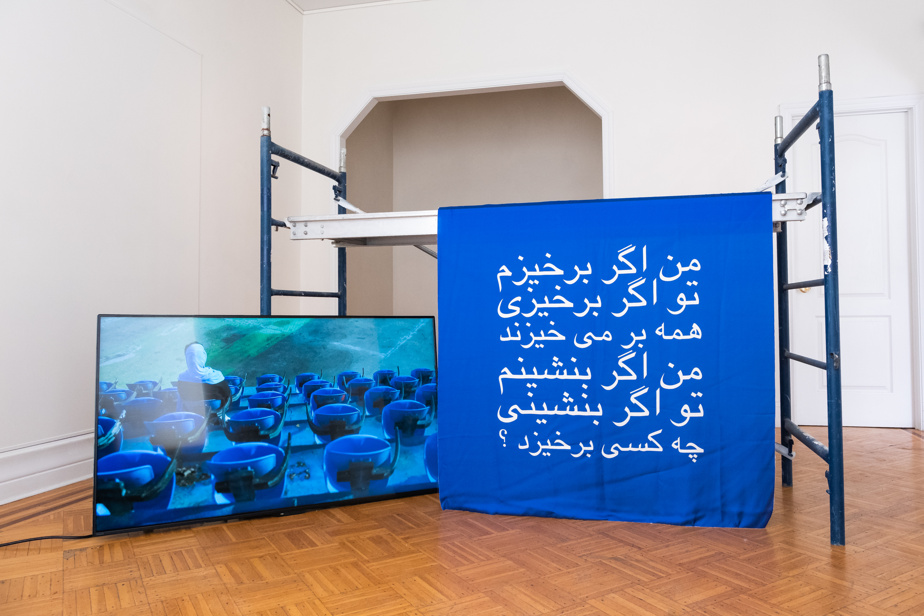At the end of December, Danielle Lysaught, co-founder of Projet Casa, a place of contemporary art located on the edge of Jeanne-Mance Park, was very struck by the courageous revolt of women in Iran.
She contacted Montreal historian and curator of Iranian origin Mojeanne Behzadi to quickly put together an exhibition evoking their struggle, but also that of the Kurds (in Turkey, Syria, Iran and Iraq), Afghan women and other oppressed people. . “Because it doesn’t just affect women, but also LGBTQ communities and even men,” Behzadi said. True feminism includes everyone. And free everyone. »
We visited the expo on Wednesday. It couldn’t have been better, during International Women’s Day. In addition, March 20 will be Nowruz, the Iranian holiday that celebrates the New Year of the Persian calendar. From the first installation, we are immersed in the horrors of Iranian theocracy. Substitute, by Leila Zelli and Guillaume Pascale, includes a video in which Leila Zelli pays tribute to Sahar Khodayari, the young woman who set herself on fire in Tehran in 2019 after being accused of wanting to attend , disguised as a man, at a soccer match, a pastime forbidden to women in Iran.
Leila Zelli, a blue scarf on her head, sits in the empty stands of CF Montreal, near the Saputo stadium. She does not attend the sports meeting from which we hear the cheers. On her scarf is embroidered an excerpt from a poem by the Iranian poet Hamid Mosadegh. “If I stand up, if you stand up, everyone will stand up. If I sit down, if you sit down, who will stand up? »
Quebec artist of Kurdish origin, Diyar Mayil is interested in illustrating the fact that during popular revolts, the number of victims is so important and striking that it tends to make us forget what the pain of each person really is. victim. With her installation Femmestatistics, she wanted to represent the seriousness of discrimination while paying homage to personal suffering that is too often ignored.
The work is an abacus where strands of hair are wrapped around the rods. When you see this hair, you think of citizens of the world, especially artists, who have supported Iranian women by filming themselves cutting a lock of hair on social networks. Diyar Mayil also performs (especially today, Saturday, from 2 p.m. to 5 p.m.) during which she counts hairs one after the other, to express the tenacity, frustration and exhaustion of women in struggle.
Mojeanne Behzadi has also chosen to exhibit the sculpture Study for a Garden, 2017, by Abbas Akhavan, the Iranian artist who won the Sobey Prize in 2015 and who has recently moved to Montreal. The work, which belongs to the Caisse de depot et placement du Quebec, is a bundle of branches molded in bronze and placed on the ground. The branches look natural and harmless but are sharpened at one end, reminiscent of spears. A tension between peace and violence, which sticks to the theme explored in To freedom.
On the upper floor, the visitor is invited to listen to an hour-long sound work, Making Collective Prophecies, by the Iranian collective Only Voice Remains, based in London and “who act according to transnational, queer and feminist values”. The sound piece is a montage of testimonies from Iranian, Kurdish, Palestinian or queer women. With poetry, music, reflections and sound bites from protests. A touching work that we follow by reading a printed transcription.
The exhibition is accompanied by a community space where you can consult monographs, catalogs and books related to the artists and the fights led by those thirsty for freedom. Including in Quebec, when we recognize the snapshot of photographer Alain Chagnon, taken in 1973, of a pro-choice protester holding a sign saying “It’s up to the woman to decide”.
“This community piece is to create solidarity,” says Diyar Mayil, illustrating the purpose of this exhibit. Open up to others, show empathy and support for beings in resistance, but also for these committed artists who believe in the importance of respect, justice and freedom, at a time when democratic values have lead in the wing in many countries.
